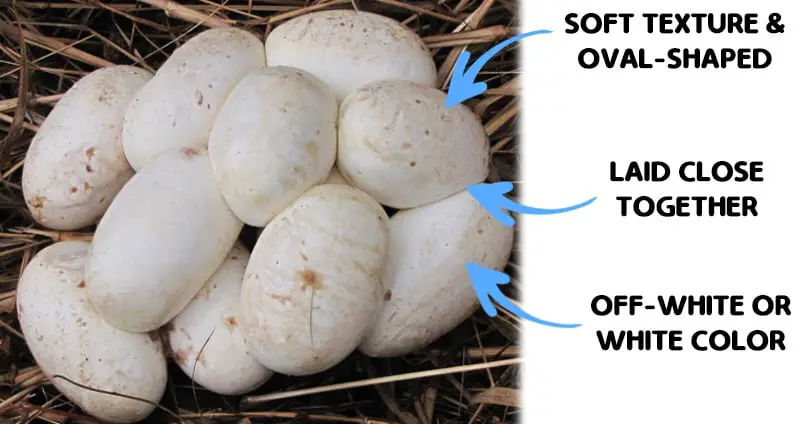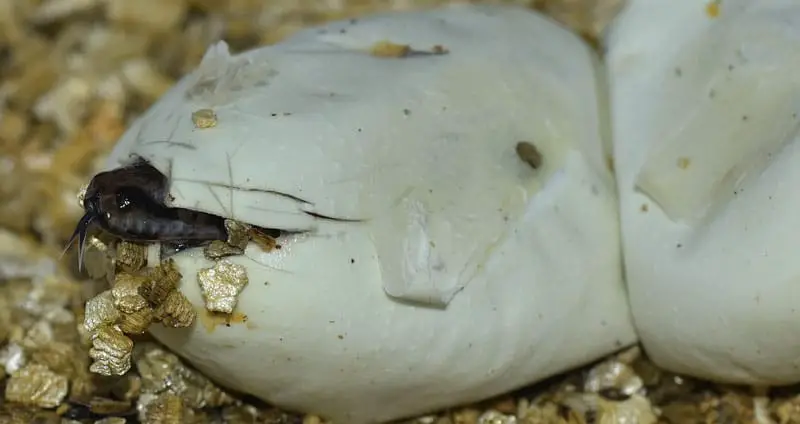Did the snake come before the egg? Or… was it the chicken? Snake eggs are very interesting things that are surrounded in mystery and uncertainty with not many people knowing a lot about them. Whether you have a pet snake yourself or you’re just a curious outdoor explorer, it would be beneficial to be aware of the many caveats of snake eggs.
Whatever the case may be, below we’ve laid out 10 important snake egg facts that every snake enthusiast should know.
Table of Contents
1. How To Identify Snake Eggs
First of all, you should examine key characteristics of the egg, including the appearance, shape, and hardness. The most important and telling physical characteristic of a snake egg is the shape: snake eggs are oblong.
Some African and Asian species lay eggs with bumpy textures like a ginger root or thick grain rice. In terms of color, snake eggs can either be white, beige, or off-white.
Snake eggs are not hard like most eggs that you may be familiar with. Instead, they have more of a soft and leathery texture. The egg has this texture due to the fact that the baby snake inside needs to break out!
Baby snakes use their “egg tooth” to break through the membrane and then lose that “tooth” shortly after birth.
Unfortunately, this unique and interesting texture results in a tender egg that’s quite fragile. In fact, one wrong movement from the mother such as brooding or rolling over can kill the embryo inside. This results in snake breeders taking great care with a clutch once it’s laid.


2. Where Would You Find Snake Eggs?
Snakes lay their eggs in a variety of different places, but they’re still picked to be safe and optimal locations for the eggs. The snake often picks an area with natural substrate, such as soft soil, leaves, or sawdust in order to protect the eggs and retain moisture.
Additionally, they tend to choose an area that has a healthy level of humidity but isn’t overly damp.
While some snakes will get crafty and hide their eggs in safer locations that are out of the way (such as logs or in holes), others will lay their eggs fairly out in the open.
This doesn’t matter to some species, as they do something called “brooding” which involves staying with the eggs and keeping them safe until they hatch.
3. How Many Eggs Does A Female Snake Lay?
The clutches of snake eggs (a group of eggs laid at once) are usually around 1 to 100 eggs. The bigger snake species can even lay more than 100 eggs.
Some snakes lay around half the amount (25-50 eggs) for the first batch of the season, then they’ll lay the second half later on as a second batch.
4. How Long Does It Take For Snake Eggs To Hatch?
Incubation time could take anywhere from 45 days up to 90 days, depending on the snake species. The average hatching time is around 57 days.
Sometimes, baby snakes will stay inside the eggs a couple days after hatching so they can soak up the nutrients that came from the egg before being welcomed into the world.
When the baby snake inside the egg grows, the size of the egg also grows. The shape of the egg becomes more oval as hatching time comes closer.
5. How To Care For Snake Eggs
In caring for snake eggs after they’re laid, incubation is key. There are 2 ways that you can care for the snake egg by either buying a reptile incubator or making your own DIY incubator at home for surprisingly cheap.
Both of these methods are equally effective as long as you practice good care with the moter and eggs. Regardless, it’s important to keep in mind these general guidelines to make sure that your eggs have the best chance at survival:
- Always make sure to pre-heat the incubator 48 hours in advance before placing your snake eggs inside. The climate inside should be stable before the eggs are ever introduced. This is done so that eggs don’t experience any temperature changes that could prove to be fatal.
- You must have 2 thermometers checking the temperature at all times. One thermometer should be used to control the climate.
- Make sure that your incubator has enough humidity by placing some sort of water bath inside. Most store-bought incubators already come with one, but if you’re making your own incubator, you should hang the eggs in the container above the water bath.
6. Do All Snakes Lay Eggs?
The answer is no, not all snakes lay eggs. Actually 70% of all the snake species lay eggs, and with the remaining 30% giving live birth.
Snakes that lay eggs are called oviparous (i.e, pythons, kingsnakes, pine snakes, milk snakes). Meanwhile the rest belong to the ovoviviparous group.
Boa constrictors, rattlesnakes, and garter snakes all give live birth and are classified as ovoviviparous snakes.
While they don’t lay eggs, their babies don’t come out ready to go. Instead, they’re covered in a very thin membrane that they quickly break out of with their egg tooth.
7. By Now We Now: Climate Matters
Snakes that live in colder areas mate in late spring and lay their eggs in early summer, while tropical snakes mate any time of the year. Snakes could reproduce either once a year or once every 3 years.
Their reproductive cycle is largely determined by the climate that they’re in, so this needs to be considered if you’re planning on keeping and breeding your own snakes.
For example, ball pythons are typically kept in temperatures around 78°F and humidity levels around 60-70%. However, during mating season, the temperature of your ball python’s room needs to be raised to 80°F with a hot spot on their enclosure measuring about 88°F.
8. Types Of Snakes & Their Egg Laying Habits
If you’re planning on keeping a snake as a pet, it helps to be aware of that particular snake’s egg-laying habits. In terms of incubation time, you can expect most snake eggs to take right around 2 months.
However, the amount of eggs in a clutch can vary greatly depending on the snake’s species.
- Corn snakes – 60 days incubation time, 8-30 eggs / clutch
- Ball pythons – 55 days incubation time, 4-10 eggs / clutch
- Garter snakes – 60 days incubation time, 10-40 eggs / clutch
- Kingsnakes – 55-75 days incubation time, 10-24 eggs / clutch
9. Are The Eggs In My Yard Snake Eggs?
You can actually find out by yourself! Gently handle the egg with care, bringing it into a dark room and hold it against a small light (a small bulb or a torch).
As you hold it up against the light, if the shadow of the embryo is round or ball-shaped, it is a snake egg! Be very careful since the egg is soft shelled and leathery.
10. After Discovering Snake Eggs
If you discover snake eggs out in nature, leave them alone! Even if they’re the eggs to a venomous snake, if they’re away from humans they should be left alone to live their lives.
However, if you find snake eggs in an area that gets a lot of foot traffic, you should think about contacting the correct people.
You can contact your local pest control center so that they can properly handle the eggs. Often times they’ll be able to identify the type of snake egg that’s been laid and deem whether or not they belong to a dangerous snake.
You may also consider consulting a local reptile rescue/sanctuary that could possibly be interested in the eggs!
Be very careful handling the eggs yourself! Since the eggs are so fragile, even a light grasp of them could damage the embryo inside.

